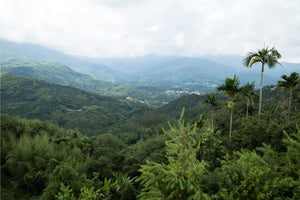The Oolong Spectrum
Oolong is considered one of the six types of tea (others being green, black, white, yellow, and dark), but out of all the different types it has the largest range of flavor profiles. The scientific definition of oolong is ‘partially oxidized’, thus it can fall anywhere in the range between green tea (unoxidized) and black tea (fully oxidized).
As oolong becomes more oxidized, its aromas tell the story of the life cycle of a plant, from green bud to flower, young fruit, ripe fruit, and finally to dried fruit or even fermentation. The below graphic will give you an idea of where many of our oolongs fall within this spectrum, although it is far from exhaustive or exact.
There is also a second axis not shown in the graphic, that would be roasting level. All oolong tea goes through some level of roasting, or curing over heat, but some have a more prominent flavor of the roast. The roast will further concentrate and deepen the flavors of the tea, and can shift some of the sweet notes into savory ones.
Baozhong
The lightest, most delicate oolong in Taiwan is Baozhong. It's the closest to green tea in its oxidation level, and very light bodied. Notes of flowers and even snappy green beans are common. Broth can be a jade color to light yellow.
High Mountain Oolong
The most classical flavor of Taiwan's famed high mountain oolong is light and creamy with notes of flowers and young fruit. Because of the high elevation, these teas will have lots of complexity in the nose. The color of the broth is yellow-gold, and because of the rolling process, the tea is just slightly more 'matured' than Baozhong. This will lead to a thicker buttery broth and a touch more body, although still light.
Dong Ding
Dong Ding was the precursor to High Mountain Oolong, and the first to be rolled into the now characteristically Taiwanese oolong balls. This tea goes through a more vigorous 'shaking' process that encourages deeper oxidation, and really requires a substantial (though not heavy) roast. The roast makes the tea feel more concentrated and thick in the mouth. It can be medium to heavy bodied, and good Dong Ding has a brisk taste and long throaty finish.
Tie Guan Yin
Tie Guan Yin has two major styles, but within Taiwan's classic oolongs we're talking about the more traditional, heavy oxidized-heavy roasted style that originally made the varietal famous. This tea is very thick and heavy in the mouth, with lots of aftertaste. Broth is dark amber with very mature notes. The style was copied from Anxi, where the cultivar originated. In this way, it is more of a holdover from old world production than a uniquely Taiwanese tea, although the Taiwanese do it quite well and make it their own. It's also harder and harder to find, being labor intensive and less popular with younger generations of tea drinkers.
We don't always have a traditional style Tie Guan Yin available. They can be very difficult to find due to difficult processing and scarcity of the cultivar in Taiwan.
Oriental Beauty
Light bodied and very fragrant, but notes center around honey, peaches and rose. The broth is a pale orange-gold. The most oxidized of the traditional oolong teas in Taiwan. These are usually about 60-70% oxidized. Young buds are preferred to mature leaves (unlike other oolong), and it is harvested when the yearly traveling 'tea jassid' insects invade the tea crop to create the unique honey aroma. Very delicate and elegant tea.
Red Oolong
Red Oolong is what would happen if oolong tea and black (AKA Red) tea had a baby. It is oxidized as much as black tea, but rolled like an oolong. It is also made of oolong material by oolong makers. It is very flavorful, with notes towards stone fruit, dried fruit and caramel. It's a very popular style for its big flavor and sweet taste.
GABA Oolong
A version of red oolong, this tea is processed in a special way to bring out more of the relaxing GABA amino acid. It is anaerobically fermented to bring out a higher GABA content. GABA has a uniquely tangy fruit taste and a sweetness that reminds me of the yeasty smell of fresh baked buns.
Aged Oolong
After a long enough time in storage, dry tea leaves will continue to slowly oxidize and concentrate themselves. The result is about the most deep, sinking, earthy feeling of any oolong 'style'. However, any oolong can be aged, which adds levels of complexity. An aged Tie Guan Yin is very different from an aged Oriental Beauty. There's something ineffable about the aroma of properly aged oolong. It seems to let go of flashy aromas of youth and become the most purely 'tea' version of itself.
There are many teas that don't fit in these categories. Tea is alive and always changing, and there are infinite variations, innovations and combinations.
As you choose a tea to enjoy, we hope you'll notice how it makes your body feel. Greener teas are more cooling, and more oxidized teas are more neutral to warming. We drink tea according to our mood, time of day, weather, and season. A Baozhong may hit the spot on a sweltering summer afternoon, while an aged oolong may be perfect on a cozy winter night. We like to start people off with Dong Ding as it's neutral to slightly warm.
I hope this will give newcomers a place to start!
Click here to read more about tasting for quality in any tea style.


